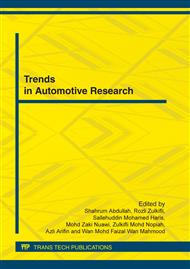[1]
B.D. Agarwal and L.J. Broutman: Analysis and performance of fiber composites, John Wiley and Sons (1990).
Google Scholar
[2]
L. Iannucci: Dynamic delamination modelling using interface elements, Computers and structures Vol. 84 (2006), pp.1029-1048.
DOI: 10.1016/j.compstruc.2006.02.002
Google Scholar
[3]
W.J. Cantwell and J. Morton: The significance of damage and defects and their detection in composite materials: a review, The journal of strain analysis for engineering design, Vol. 27 (1) (1992).
DOI: 10.1243/03093247v271029
Google Scholar
[4]
M.O. Richardson and M.J. Wisheart: Review of low-velocity impact properties of composite materials, Composites part A Vol. 27A (1996), pp.1123-1131.
DOI: 10.1016/1359-835x(96)00074-7
Google Scholar
[5]
E. Greenhalgh and M. Hiley: The assessment of novel materials and processes for the impact tolerant design of composite aerospace structures, Composites part A Vol. 34(2) (2003), pp.151-161.
DOI: 10.1016/s1359-835x(02)00188-4
Google Scholar
[6]
D.A. Saravanos and A.P. Christoforou: Impact response of adaptive piezoelectric laminated plates, AIAA journal, Vol. 40 (10) (2002), p.2087-(2095).
DOI: 10.2514/2.1543
Google Scholar
[7]
G.A. Davies, D. Hitchings and J. Wang: Prediction of threshold impact energy for onset of delamination in quasi-isotropic carbon/epoxy composite laminates under low-velocity impact, Composites science and technology Vol. 60 (2000), pp.1-7.
DOI: 10.1016/s0266-3538(99)00092-5
Google Scholar
[8]
P. Robinson and D. Q Song: A modified DCB specimen for mode I testing of multidirectional laminates, Journal of composite material Vol. 26 (1992), pp.554-557.
DOI: 10.1177/002199839202601101
Google Scholar
[9]
Y. Mi, M.A. Crisfield, H.B. Hellweg, and G.A. Davies: Progressive delamination using interface elements, Journal of composite materials Vol. 32(14) (1998), pp.1246-1272.
DOI: 10.1177/002199839803201401
Google Scholar
[10]
F. Aymerich, F. Dore and P. Priolo: Prediction of impact-induced delamination in cross-ply composite laminates using cohesive interface elements, Composites science and technology Vol. 68 (2008), pp.2383-2390.
DOI: 10.1016/j.compscitech.2007.06.015
Google Scholar
[11]
E.F. Crawley and K.B. Lazarus: Induced strain actuation of isotropic and anisotropic plates, AIAA journal Vol. 29 (6) (1991), pp.944-951.
DOI: 10.2514/3.10684
Google Scholar
[12]
R.B. Williams: Nonlinear mechanical and actuation characterization of piezoceramic fiber composites. PhD thesis, Viginia Polytechnic Institute and State University (2004).
Google Scholar


